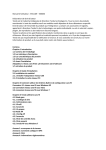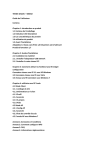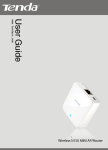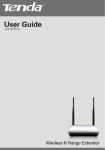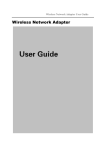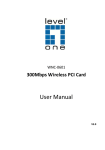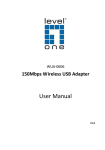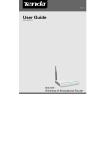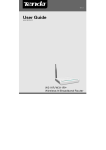Download Tenda W311P
Transcript
Tenda Wireless Network Adapter User Guide Tenda Wireless Network Adapter User Guide Copyright Statement is the registered trademark of Shenzhen Tenda Technology Co., Ltd. All the products and product names mentioned herein are the trademarks or registered trademarks of their respective holders. Copyright of the whole product as integration, including its accessories and software, belongs to Shenzhen Tenda Technology Co., Ltd. Without the permission of Shenzhen Tenda Technology Co., Ltd, any individual or party is not allowed to copy, plagiarize, reproduce, or translate it into other languages. All the photos and product specifications mentioned in this guide are for references only. Upgrades of software and hardware may occur, and if there are changes, Tenda is not responsible for notifying in advance. If you would like to know more about our product information, please visit our website at www.tenda.cn. Tenda Wireless Network Adapter User Guide Contents Chapter 1 Product Introduction............................................... 3 1.1 Package Contents ................................................................. 3 1.2 LED Indicator Description ...................................................... 3 1.3 Product Features ................................................................... 4 1.4 Product Usage ....................................................................... 4 1.5 Before Installation .................................................................. 5 1.6 Disable other manufacturers’ wireless network adapters ...... 5 1.7 Product Maintenance............................................................. 7 Chapter 2 Installation Guide .................................................... 8 2.1 Hardware Installation........................................................... 8 2.1.1 Install the USB network adapter ............................................. 8 2.1.2 Install the PCI network adapter............................................... 8 Chapter 3 How to use the Windows Built-in Wireless Configuration ........................................................................... 13 3.1 Wireless Network Connection under Windows XP.............. 13 3.2 Wireless Network Connection under VISTA ........................ 17 3.3 Wireless Network Connection under Windows 7................. 20 Chapter 4 Tenda Wireless Utility ........................................... 22 4.1 Station mode (Client Mode) ................................................. 23 4.1.1 Site Survey............................................................................ 24 4.1.2 Link Information................................................................... 27 4.1.3 Profile ................................................................................... 28 4.1.4 Advanced .............................................................................. 39 4.1.5 About..................................................................................... 40 -1- Tenda Wireless Network Adapter User Guide 4.1.6 Help....................................................................................... 41 4.2 AP mode .............................................................................. 41 4.2.1 Config AP ............................................................................. 43 4.2.2 Advanced .............................................................................. 45 4.2.3 Access Control List ............................................................... 46 4.2.4 Associate List........................................................................ 48 4.2.5 AP Mode under Windows 7 .................................................. 49 Appendix 1: Acronyms and Terms ......................................... 50 Appendix 2: How to Set WPS ................................................. 52 Appendix 3: FAQ ..................................................................... 60 Appendix 4 :Regulatory Information .................................... 65 -2- Tenda Wireless Network Adapter User Guide Chapter 1 Product Introduction Thank you for choosing this Tenda wireless adapter! The Tenda wireless adapter supports IEEE wireless standards, and is able to quickly process file transfer, video, multi-media and other applications that require higher bandwidth. This Tenda wireless adapter also integrates wireless configuration program, which makes it easy and quick to set up the wireless client. Besides, Soft AP is supported for fast wireless network establishment, and WPS encryption supported for you to quickly encrypt and secure your wireless network. All in all, the Tenda wireless adapter is easy-to-use, and of robust signal, long transmitting distance. 1.1 Package Contents ¾ One Wireless network adapter ¾ One Software CD (includes user guide and driver) The above list is for your reference only,the actual contents may differ according to the product you purchase. 1.2 LED Indicator Description There is one status LED indicator on the side of the wireless network adapter. It lights up and stays ON when working correctly, and flashes when transferring data. -3- Tenda Wireless Network Adapter User Guide 1.3 Product Features ¾ Supports soft AP feature ¾ Detects wireless network and adjusts transmitting rate automatically ¾ Provides two working modes: Infrastructure and Ad-Hoc ¾ Supports WEP data encryption and WPA-PSK/WPA2-PSK encryption methods ¾ Supports WPS (Wi-Fi Protected Setup) encryption to secure your wireless network ¾ Complies with Windows 7/XP/ 2000/Vista, Linux, MAC OS, etc. 1.4 Product Usage This Tenda Wireless Adapter offers a fast, reliable and extendable solution for wireless access. It is mostly used in the following circumstances: 1. Enables staff members who require higher mobility, to have access to the wireless network anywhere inside their company. 2. Enables wireless communication for companies or places which are not suitable for wired LAN installation because of budget or building environment restrictions, such as historical buildings, rentals, or places for short-term usage. 3. Suitable for Enterprises or individuals requiring to regularly alter the networking topology 4. Helps enterprises or individuals who would like to use -4- Tenda Wireless Network Adapter User Guide wireless to establish wireless network quickly and frees them from the trouble of cable distribution. 1.5 Before Installation 1.Please read through the whole user guide before you install and use this product. 2.Please close or uninstall the configuration programs of other manufacturers’ before you install the configuration programs of Tenda network adapters to avoid possible UI (user interface) conflict. 3.To avoid possible network conflicts between this Tenda network adapter and those of other manufactures’, we recommend that you first disable the network adapters of other manufacturers before installaing the driver. 1.6 Disable other manufacturers’ wireless network adapters 1. Right click “My Computer” and select “Manage” -5- Tenda Wireless Network Adapter User Guide 2. On the Computer Management screen ,select “ Device Manager” - “Network adapters”, and right click the network adapter you want to disable and click “Disable” 3. Click the “Yes” button on the dialogue box to disable the -6- Tenda Wireless Network Adapter User Guide network adapter. 1.7 Product Maintenance 1. Please keep the product away from water and humid environment to guarantee its normal performance 2. Protect it against hazardous substances (such as acids, alkalis etc). 3. Please don’t directly expose the adapter to the sunlight or excessive heat. 4. Please contact Tenda tech support if any problems occur. -7- Tenda Wireless Network Adapter User Guide Chapter 2 Installation Guide This chapter will guide you through the process of installing the network adapter software package, with the included software CD. The package integrates driver and configuration software. Thus, when you are installing the driver, the configuration software will be installed automatically as well. The software installation steps and operating guide in this user guide are explained under Windows XP, Installation steps for other operating systems are similar. 2.1 Hardware Installation 2.1.1 Install the USB network adapter Please insert the Wireless USB Adapter into the USB port of your computer. 2.1.2 Install the PCI network adapter Insert the wireless adapter into the PCI slot of your computer when it is turned off and then start it(Please make sure the PCI -8- Tenda Wireless Network Adapter User Guide adapter’s “gold fingers” are clean. If the PCI adapter can not be identified after being inserted into the mainboard slot,or the adapter can not scan signals after the driver being installed, please shut down your computer and clean the adapter,and then re-install). 2.2. When The “Found New Hardware Wizard” system dialogue pops up, we recommend that you select” Cancel” and use the included Setup Wizard software CD for fast installation. 2.3 Put the included software CD into the CD drive of your computer ,and the driver should run automatically , a Welcome screen should pop up, just click the “RUN” button.( Double click “Tenda.exe”in the software CD and manually install when it -9- Tenda Wireless Network Adapter User Guide doesn’t auto-run). 2.4 Select “I accept the terms of the license agreement” and click “Next”. 2.5 Two set up types are provided: one is “Install driver -10- Tenda Wireless Network Adapter User Guide only” ,the other is “Install driver and Tenda WLAN Config Tool”. NOTE: you may select the first method when you are accustomed to use the WINDOWS built-in wireless configuration program.However, this program doesn’t support AP mode, WPS, and the WPS button on the wireless adapter. To use these advanced features, the second method is recommended. 2.6. Click “Install” to begin the driver installation. -11- Tenda Wireless Network Adapter User Guide 2.7 Click “Finish” to complete the installation. -12- Tenda Wireless Network Adapter User Guide Chapter 3 How to use the Windows Built-in Wireless Configuration This chapter explains to users who don’t install Tenda configuration program how to use Windows Built-in Wireless Configuration to connect to the wireless network . Use of the Windows Built-in Wireless Configuration requires enabling Wireless Zero Configuration service(the default is enabled). 3.1 Wireless Network Connection under Windows XP 1. Right click “My Network Places” on the desktop and select “Properties”. 2. Open the network connection.Right click “Wireless Network Connection” and select “View Available Wireless Networks” as shown below. -13- Tenda Wireless Network Adapter User Guide 3. On the right of the screen displayed are the currently scanned wireless networks. If the one you want to connect has not been scanned, click “Refresh Network List” to update the network list. Select the wireless network you want to connect, and click “Connect” or double click this wireless network. Input the key in the key dialogue box (the key input is case-sensitive) then click “Connect”. -14- Tenda Wireless Network Adapter User Guide NOTE: If the wireless device you are connecting to is not encrypted, the key dialogue box will not pop up. 5. When it shows “Connected” as the picture below, then you can enjoy wireless access to Internet now. 5. You can modify wireless network key from “Change advanced -15- Tenda Wireless Network Adapter User Guide settings”. 6. Select “Wireless Networks”and choose the one you want to modify, and then click “Properties”. -16- Tenda Wireless Network Adapter User Guide 6. Modify the key in the appearing dialogue box. 3.2 Wireless Network Connection under VISTA 1. Click the Wireless Connection icon in the lower right corner of your desktop and select “Connect to a network” as shown below. 2 Select the wireless network you wish to connect and click “Connect” or double click the wireless network to connect. Click -17- Tenda Wireless Network Adapter User Guide the Refresh icon in the upper right corner to update the network list if you don’t find the specified wireless network. 3. If the wireless network that you are connecting has enabled security mode, you’ll be prompted to enter the network key .Click “Connect” after you enter the correct key. 5. The following screen will -18- appear after successfully Tenda Wireless Network Adapter User Guide connected to the wireless network. 6. If you want to change the wireless network key, just right click the wireless network’s SSID and then select “Properties”. 7. You can modify the key from the appearing dialogue box. -19- Tenda Wireless Network Adapter User Guide 3.3 Wireless Network Connection under Windows 7 1. Click the wireless connection in the lower right corner of the computer’s desktop to view the available wireless networks. Select the wireless network you wish to connect and click “Connect” or double click the wireless network to connect. If you don’t find the specified one, please click the refresh icon in the upper right corner to update the list. -20- Tenda Wireless Network Adapter User Guide 2、 If the wireless network you are connecting is encrypted, you’ll be prompted to enter the key. Click “Ok” after you enter the correct key. 3. It shows “Connected” after successfully connected. You can -21- Tenda Wireless Network Adapter User Guide disconnect it, view its status or modify the wireless network properties by right click the wireless network Chapter 4 Tenda Wireless Utility When you are installing the driver, select “Install driver and -22- Tenda Wireless Network Adapter User Guide Tenda WLAN Config Tool” and the adapter driver and client utility will be installed. All functions of this adapter can be configured via Tenda’s utility interface (in the following text it is abbreviated as UI). Select “Start”—“All Programs” —“Tenda Wireless”— Tenda Wireless Utility”, or click the “Tenda Wireless Utility” shortcut on your PC’s desktop to start the UI. 4.1 Station mode (Client Mode) Station mode (Client Mode) Overview It is a common solution to use the wireless network adapter as a client to receive signals. Main interface for station mode -23- Tenda Wireless Network Adapter User Guide The function buttons on the top(From L to R )are respectively Site Survey, Link Information, Profile, Advanced, About, Help, and MiniSize. While the left column displays Turn On/Off RF, Security /No security, and Signal status. 4.1.1 Site Survey The “Site Survey” screen displays currently scanned wireless signals and you can click one to connect the signal. Select one and you may view the AP’s MAC address, wireless mode (A/B/G/N), authentication type, and encryption type, or WPS authentication and signal strength. Before you connect to a wireless network, please click the “Rescan” button to update the wireless network list and select the one you wish to connect, then click the “Connect” icon. -24- Tenda Wireless Network Adapter User Guide For the networks that are not encrypted, you can directly click “Connect”. However, for the encrypted wireless networks,a “Profile” dialog will pop up and you must select the corresponding authentication type and encryption type,and then click the “Next” button to input the correct key.Please note that this type of connection will not create a profile ,thus next time connect to this network you still need to select it manually. -25- Tenda Wireless Network Adapter User Guide The detailed explanations about the authentication and encryption are as follows: WEP:Supports 10/26-bit Hex characters and 5/13-bit ASCII. WPA-PSK : Supports 8-63-bit ASCII and 8-64-bit Hex characters. WPA2-PSK : Supports 8-63-bit ASCII and 8-64-bit Hex characters. WPA-PSK/WPA2-PSK:Supports 8-63-bit ASCII and 8-64 -bit hex characters. NOTE: The Hex characters consist of numbers 0~9 and letters a-f. -26- Tenda Wireless Network Adapter User Guide ASCII characters consist of any Arabic digitals/letters and characters. 4.1.2 Link Information After successfully connected to one wireless network, you can view its detailed information by clicking the “Link Information” on the main interface. 1. “Link Status” screen displays the detailed information of the connected AP including its SSID,MAC address, authentication type, encryption type, network type and channel. -27- Tenda Wireless Network Adapter User Guide 2. “Throughput” screen displays the signal strength of each of the wireless adapter’s antennas and the link quality. 3.”Statistics” screen is used to count the total Rx and Tx data packets, including transmitted,retransmitted and fail to receive ACK after all retries.You can click the “Reset Counter” button to clear the count. 4.1.3 Profile Except the above common connection type, you can also connect to the wireless network by adding a profile on the “Profile“screen.The Profile screen is used to save the wireless network parameters. When the adapter is successfully connected to a network, the profile name of this network will -28- Tenda Wireless Network Adapter User Guide automatically be added here, which helps the adapter to quickly connect to the wireless network next time. However, there’s one exception that when you have set the hidden SSID,namely the SSID can not be scanned,then you must manually connect by adding the profile name.The main interface is as shown below. Add: create a new profile Delete: delete the existing profile Edit: modify the existing profile Add WPS Profile: WPS setting requires that the connecting wireless device support WPS function. WPS helps you to fulfill wireless encryption fast as well as secure your wireless network. For detailed setting steps, refer to appendix2. There are two network types for your option when clicking the -29- Tenda Wireless Network Adapter User Guide “Add” button to add wireless adapter connection: Infrastructure and Ad-Hoc. Infrastructure is an application mode that integrates the wired and wireless LAN architectures. It is different from Ad-Hoc in that in this mode the computer installed with the wireless network adapter has to fulfill the wireless communication via AP or wireless router. It can be devided into two modes:“wireless AP + wireless network adapter” and “wireless router + wireless network adapter”. Ad-Hoc is a special wireless mobile network application mode. All nodes in the network are equal.Usually it is used to share -30- Tenda Wireless Network Adapter User Guide resources by connecting the opposing computer’s wireless adapter. 1. Infrastructure Profile Management When you are connecting the wireless adapter to an AP or a wireless router, please select the Infrastructure mode. Click the “Add”button and select the network type as” Infrastructure”,and enter the profile name and SSID or you can find the SSID you wish to connect from the drop-down list. Click the next button to select the authentication type and encryption type such as WPA-PSK and AES, and then input the key and click next. -31- Tenda Wireless Network Adapter User Guide After a profile is successfully added, the profile name can be seen on the profile list,you can edit , import or export the profile,click “Active” to finish the connection,now you can also view the detailed connection Information”screen. -32- status on the “Link Tenda Wireless Network Adapter User Guide NOTE: If the SSID broadcast function of the wireless router or AP you wish to connect is disabled, then the wireless adapter can not scan the SSID, thus you need to connect by creating the corresponding profile. 2.Ad-Hoc Profile management Using the Ad-hoc mode to establish a wireless network requires -33- Tenda Wireless Network Adapter User Guide that each computer should be equipped with a wireless network adapter. By connecting these wireless adapters, computers are able to share the resources. The detailed setting steps are as follows: 1)Firstly you’ll have to allocate a static IP to each wireless adapter to be connected in Ad-hoc mode. a.Right click “My Network Places” on your computer’s desktop and select “Properties”. b.Right click “Wireless Network Connection”, and select “Properties” -34- Tenda Wireless Network Adapter User Guide c.Select “Internet Protocol(TCP/IP)”and click “Properties”. d. Please enter the IP address and subnet mask, and make sure this IP address is not used by other devices in the network.For example: if your wireless adapter’s IP address is 192.168.0.1 , then set other wireless adapters’ IP addresses -35- within the range of Tenda Wireless Network Adapter User Guide 192.168.0.2—192.168.0.254.Click “Ok” to save the settings. 2) Create a new Ad-hoc profile Click the “Add” button and enter the network name in the SSID field to identify the wireless network, and select Ad-hoc as the network type and then select the channel. -36- Tenda Wireless Network Adapter User Guide Click the “Next” button to select the authentication type and encryption type and then input the correct key and click “Next”. After a profile is successfully added,the profile can be seen on the profile list ,select it and click the “Active” icon on the lower right corner. -37- Tenda Wireless Network Adapter User Guide And then search for the wireless network on other clients. Double click the wireless network you have configured and you’ll be prompted for the key .After entering the key, click “Connect”. When the highlighted part shows “Connected“ ,it indicates the connection is successful. -38- Tenda Wireless Network Adapter User Guide 4.1.4 Advanced This section is used to set the wireless mode and country region code for the current wireless adapter. You have three options to choose from: 2.4G, 5G or 2.4G+5G. The widely used is 2.4G wireless adapter. To use the 5G mode of 802.11a technology, please set it here. -39- Tenda Wireless Network Adapter User Guide 4.1.5 About This screen mainly displays the version information of the UI’s different programs as well as Tenda’s copyright statement. -40- Tenda Wireless Network Adapter User Guide 4.1.6 Help Click the help button to open the user manual. 4.2 AP mode When you want to use the wireless adapter’s AP function, please right click the UI icon on the taskbar of your computer desktop and select “Switch to AP Mode”. In this mode, the wireless adapter acts as an AP to transmit -41- Tenda Wireless Network Adapter User Guide wireless signal and create a wireless network, while allowing other wireless clients to access this network. As shown in the diagram below: The PC in the left has already accessed to the Internet by using a wired network adapter, meanwhile, you install a Tenda wireless adapter (take a USB wireless adapter as an example) and its UI on this computer, and set the adapter to AP mode. By using the wireless adapters to scan the AP’S SSID to connect, the computers in the right can also access to the Internet after successfully connected In this mode, the client utility differs from that in station mode, and the main interface is as shown below. -42- Tenda Wireless Network Adapter User Guide When it is switched to AP mode, the wireless adapter will automatically set its IP address as 192.168.123.1, and other clients that connected to this AP will automatically obtain the IP addresses of: 192.168.123.X(X is any integer from 2 to 254).The function buttons on the top (From L to R )are respectively Config AP, Advanced, Access Control List, Associate List, About, Help, and MiniSize, while the left column displays Turn On/Off RF, Security /No security, and AP mode icon. 4.2.1 Config AP This screen is used to set the AP’s general parameters including SSID, wireless mode, channel, authentication type and encryption type, as shown in the picture below. -43- Tenda Wireless Network Adapter User Guide Here the authentication type is set as “Open” and the encryption type “Not Use”. -44- Tenda Wireless Network Adapter User Guide 4.2.2 Advanced This screen is used to set the advanced parameters of the wireless adapter when working in AP mode, such as No forwarding among wireless clients and TX power. -45- Tenda Wireless Network Adapter User Guide No forwarding among wireless clients: This feature isolates the communications among the wireless clients that are connected to the wireless adapter in AP mode. TX power: To adjust the transmit power for the wireless adapter 4.2.3 Access Control List Access Control is based on the wireless adapter’ MAC addresses to allow or reject a specified client’s access to this wireless network. -46- Tenda Wireless Network Adapter User Guide Access Policy: Disable: To disable the filter function. Allow All: To permit all hosts whose wireless MAC addresses are included in the list to access the wireless network, other hosts whose wireless MAC addresses have not been added to the list will be prohibited by default. Reject All: To prohibit all hosts whose wireless MAC addresses are included in the list from accessing the wireless network, other hosts whose wireless MAC addresses have not been added to the list will be permitted by default. MAC Address:To input the client’s wireless MAC address you want to filter in the physical address field. : to add the entered wireless client MAC address to the list. -47- Tenda Wireless Network Adapter User Guide : to delete an existing MAC address in the list. : to delete all clients’ wireless MAC addresses in the list. Add the MAC address of the client’s wireless network adapter to the list and select “All Allow” in the access policy drop-down list, computers whose wireless MAC addresses are not included in the list will be rejected by default. Select “All reject”, and only the host computers whose wireless MAC addresses are included in the list can not access the AP wireless network. 4.2.4 Associate List When there’s client connected to this AP and has successfully obtained the IP address ,then the client’s MAC address, AID and Status can be seen on the list. -48- Tenda Wireless Network Adapter User Guide 4.2.5 AP Mode under Windows 7 1. Under Windows 7, wireless adapters are allowed to work in both STA and AP modes. Here, the wireless adapter acts not only as a client, but also an AP to send wireless signal, which equals to an amplifier. Right click the UI icon on the lower right corner of the computer desktop and select “Switch to STA+AP Mode”. 2. You can change the SSID on the Config AP screen and control the number of the connected clients by modifying the max number of peers. AP mode has only one encryption method which is WPA2-AES by default and cannot be modified. -49- Tenda Wireless Network Adapter User Guide Appendix 1: Acronyms and Terms WLAN Wireless Local Area Network 802.11 A family of specifications developed by the IEEE for -50- Tenda Wireless Network Adapter User Guide WLAN technology. 802.11a An extension to 802.11 WLAN standards that provides up to 54 Mbps transmission in the 5 GHz UNI radio band. 802.11b An extension to 802.11 WLAN standard that provides up to 11 Mbps transmission in the 2.4 GHz ISM radio band. 802.11b uses DSSS modulation. 802.11g An extension to 802.11 WLAN standard that provides up to 54 Mbps transmission in the 2.4 GHz ISM radio band. 802.11b uses OFDM modulation and is backwards compatible with 802.11b. 802.11n higher transmission rate, supports Multi-Input Multi-Output(MIMO)technology. WEP Wired Equivalent Privacy. A security protocol for WLANs defined in the IEEE 802.11 standard. WPA Wireless Protected Access, adopts rotating keys. RSN Robust Security Network,A substitute for WPA, and it adopts 802.1x standard and advanced encryption ICS Microsoft Internet Connection Sharing enables multi-computer to share access to Internet via one PC. -51- Tenda Wireless Network Adapter User Guide Appendix 2: How to Set WPS WPS setting supports two modes :PBC and PIN. The detailed setting steps are as follows: 1.Wireless Connection in PBC Mode 1.1 Enable the router’s WPS-PBC feature. If your router provides WPS button, just press and hold it for about 1 second, then the WPS LED will be flashing for about 2 minutes, which indicates the router’s WPS feature has been enabled. Otherwise, you can also log on to the router’s web-based utility to enable the PBC mode in WPS settings screen(For detailed settings,please refer to your router’s user guide). 1.2 Perform PBC connection on the UI of the wireless adapter 1) On the main interface of Tenda’s UI, click “Profile”—“Add WPS Profile”. -52- Tenda Wireless Network Adapter User Guide 2) On the Profile screen, select “Push-Button Configuration”(PBC) and then click the “Next” button, select “Start PBC” two minutes after the router enables the WPS function. The connection is established when the negotiating process finishes. Start PBC: -53- Tenda Wireless Network Adapter User Guide Negotiating process: A profile forms automatically after the connection is successfully established. 1.3 Using the wireless adapter’s WPS button to perform PBC connection. If your wireless adapter provides a WPS button,you may use the button to perform PBC connection. a).Run the adapter’s UI and switch to STATION mode b).Two minutes after the router’s WPS-PBC is enabled,press the adapter’s WPS button to connect in PBC mode. -54- Tenda Wireless Network Adapter User Guide c).You may view the PBC connection process on the UI’s PBC screen. 2. Wireless Connections in PIN Mode On the “Add WPS Profile” screen, select “PIN ” as the WPS Method. You may select the wireless AP to be connected in WPS mode on the WPS AP drop-down List,or select “Auto “and then click the next button. 2.1 Enrollee Mode The PIN code field lists the adapter’s current PIN code, when you select “Enrollee” as the Config Mode, you need to copy this PIN code and input it in the PIN code field of the router’s WPS setting screen. Here we take Tenda W311R as an example. First enter its WPS -55- Tenda Wireless Network Adapter User Guide configuration screen,enable WPS settings and select PIN for WPS mode and then input 18686791 in the PIN code field,and then click the “Save” button. When the WPS indicator of the Router starts flashing,it indicates that WPS feature is enabled. Click the next button on the Profile screen and click “Start PIN” to start the PIN code negotiation. -56- Tenda Wireless Network Adapter User Guide 2.2 Registrar Mode On the “Add WPS Profile” screen, select the SSID of the AP that need to negotiate in WPS mode instead of selecting”Auto”.Then select”PIN” as the WPS method and click the next button to display the folowing screen: Select “Registrar” as the config mode and enter the router’s PIN code,such as 35475088 that displays on the router’s WPS screen in section 2.1, in the PIN code field here. -57- Tenda Wireless Network Adapter User Guide Now you can view the SSID ,authenticaiton type,and encrytion type that need to be negotiated by the WPS in registrar mode.These values can be modified but we recommend using the default.Here we use the defaut setting and then click the next buton. You can view the negotiation key on the screen below ,but you are not recommended to modify it,just click the next buton. -58- Tenda Wireless Network Adapter User Guide Then click “Start PIN” on the screen below to perform WPS connection. NOTE: 1.Under the WPS connection mode, when multiple routers simultaneously enable the WPS function, it may cause connection failure. 2.If the router connect to the adapter using the WPS, only one client can be connected at one time, and so if the router need to connect to multiple clients through WPS, you should repeat the WPS operation. -59- Tenda Wireless Network Adapter User Guide Appendix 3: FAQ Q1: Microsoft ICS service is pending. A1: If ICS service cannot be enabled after a long time, please re-switch from Station Mode to AP Mode ,if not successful ,please restart the computer. Q2: ICS is already bound by another network device. A2: Microsoft ICS service can only combine one group of WAN and LAN. This message indicates ICS may have been enabled by other network adapters. Please manually cancel ICS and re-switch to AP mode. Manually enable or cancel ISC. Q3: Failed to enable ICS. -60- Tenda Wireless Network Adapter User Guide A3: Microsoft ICS service can only combine one group of WAN and LAN. This message indicates ICS may have been enabled by other network adapters. 1.Please manually cancel or restart and cancel ICS, then re-switch to AP mode. 2. This dialogue box appears because virtual wi-fi miniport adapter can only be used by one wireless network adapter at a time. Please disable any other non-Tenda wireless network adapters and re-switch to AP mode. Q4: Under Windows 7,when I switch from station mode to AP mode ,the screen flashes“ Disabling ICS , please wait……”and immediately return to station screen. A4: This is because you have disabled “Microsoft Virtual WiFi Miniport Adapter”,please re-enable it and then switch to AP mode. Q5:Client cannot obtain IP when connected to soft AP of the wireless network adapter. A5:Manually set an IP address at the same net segment as that of the AP and the gateway and DNS at the IP address of AP.Thus, communication can be achieved. Q6: The SSID is not fully displayed on the wireless network list, what should I do? -61- Tenda Wireless Network Adapter User Guide A6: Keep the mouse on the displayed SSID for about 2 seconds, as the below picture shows,and you’ll see the full SSID on the appearing box. Q7: Under Windows 2000 system, IP address can not be obtained when it is switched to AP Mode. A7: Under Windows 2000 system, you have to manually configure sharing and then switch to AP. And an IP address of 192.168.0.1 will be obtained. If you still have any problem, please contact our customer service or visit our website: http://www.tenda.cn -62- Tenda Wireless Network Adapter User Guide Q8:Sometimes the UI can not be moved by the mouse and also can not be minisized,why? A8:when you are performing some configurations or connections ,the UI only activates the currently operating window,other windows are locked and can not be operated,but it will restore to normal when you close or finish the current configuration and connection . Q9: How to exit the UI? A9: Right click the system tray icon and click “Exit” on the appearing dialog. Q10: Now that the Tenda W326U wireless adapter’s driver can be installed without the Software CD, why it still provide the CD? A10: Some functions are missing for the drive integrated in the W326U adapter, and also the drive does not support the WPS button and AP mode, however, by installing the drive on the CD, the UI can be installed to fulfill these advanced features. -63- Tenda Wireless Network Adapter User Guide Q11: Why I can not normally use the Drive integrated in W326U under MAC operating system? A11:W326U can only integrates the drive under Windows system, to use W326U under MAC system, please insert the W326U to the computer with MAC OS; the system will identify the adapter as a CD, pop this CD out, and then install the MAC drive included in the CD. Technical Support Headquarter Shenzhen: Add:Tenda Industrial Zone,No.34-1 Shilong Road,ShiyanTown,BaoanDistrict,Shenzhen,China. 518108 Tel:(86)755-27657180 Fax: (86)755-27657178 Email: [email protected] Technical Support: [email protected] -64- Tenda Wireless Network Adapter User Guide Appendix 4 :Regulatory Information Eu Declaration or Declaration of Conformity Hereby, SHENZHEN TENDA TECHNOLOGY CO.,LTD, declares that this Wireless Adapter is in compliance with the essential requirements and other relevant provisions of Directive 1999/5/EC. FCC Statement This equipment has been tested and found to comply with the limits for a Class B digital device, pursuant to part 15 of the FCC rules. These limits are designed to provide reasonable protection against harmful interference in a residential installation. This equipment generates, uses and can radiate radio frequency energy and, if not installed and used in accordance with the instructions, may cause harmful interference to radio communications. However, there is no guarantee that interference will not occur in a particular installation. If this equipment does cause harmful interference to radio or television reception, which can be determined by turning the equipment off and on, the user is encouraged to try to correct the interference by one or more of the following measures: -Reorient or relocate the receiving antenna. -65- Tenda Wireless Network Adapter User Guide -Increase the separation between the equipment and receiver. -Connect the equipment into an outlet on a circuit different from that to which the receiver is connected. -Consult the dealer or an experienced radio/TV technician for help. To assure continued compliance, any changes or modifications not expressly approved by the party responsible for compliance could void the user’s authority to operate this equipment. (Example- use only shielded interface cables when connecting to computer or peripheral devices). “The antenna(s) used for this transmitter must not be co-located or operating in conjunction with any other antenna or transmitter.” FCC Radiation Exposure Statement This equipment complies with FCC radiation exposure limits set forth for an uncontrolled environment. This equipment should be installed and operated with the minimum distance of 20 cm. Operation is subject to the following two conditions: 1) This device may not cause interference and 2) This device must accept any interference, including interference that may cause undesired operation of the device. Caution! The manufacturer is not responsible for any radio or TV -66- Tenda Wireless Network Adapter User Guide interference caused by unauthorized modifications to this equipment. Such modifications could void the user authority to operate the equipment. -67-





































































